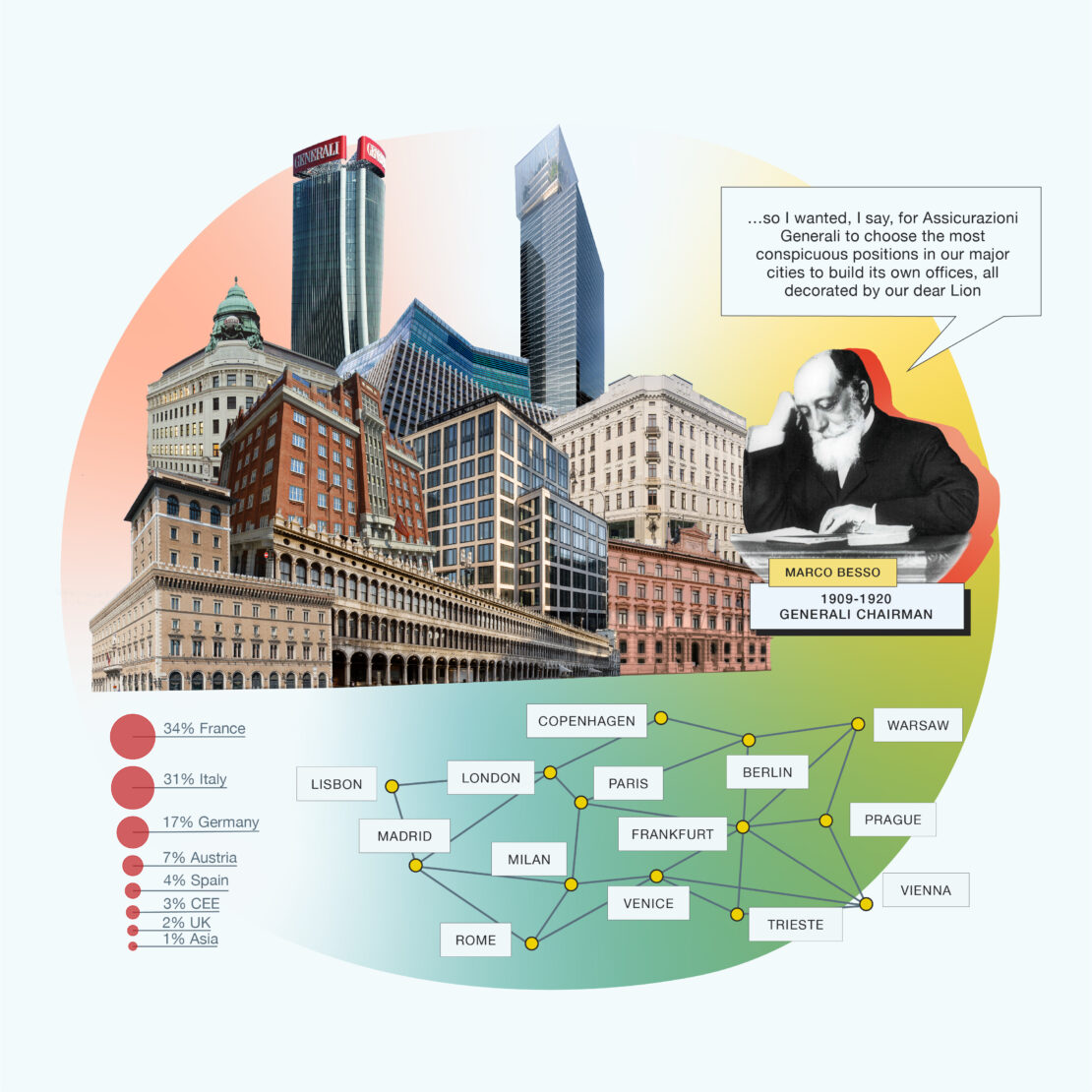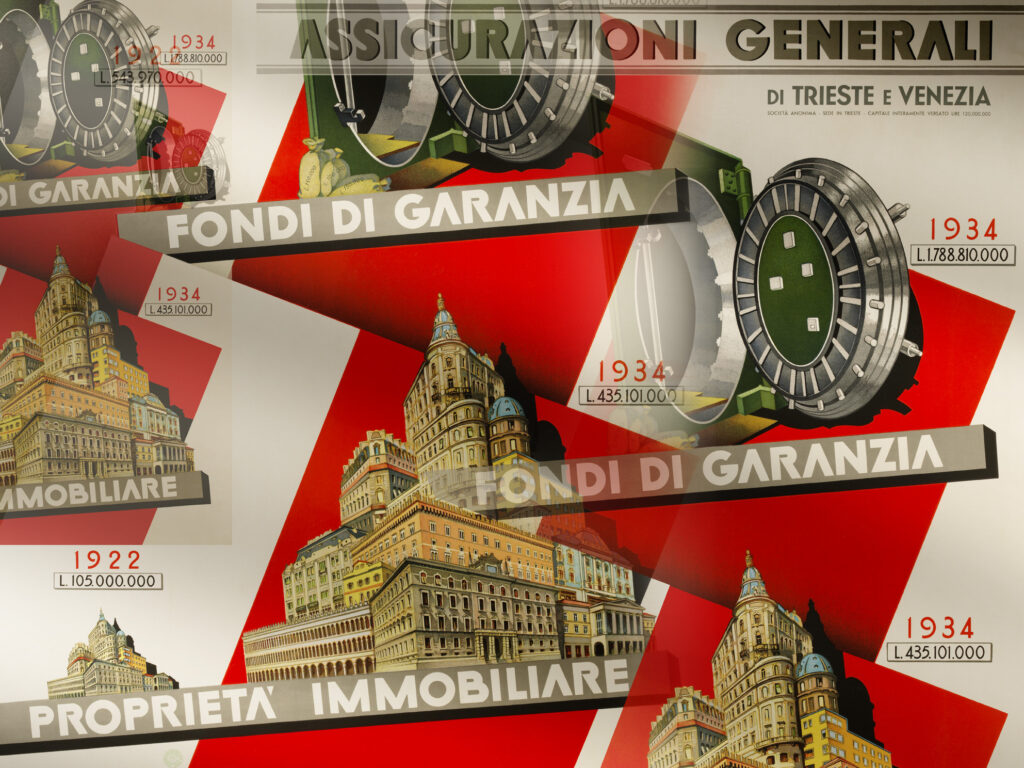1884 – The City of Generali: An International Real Estate Heritage
At the turn of the nineteenth century, Generali assumed the then-uncommon appearance of a “group”, with subsidiaries and investee companies scattered between Italy and central Europe. Its vocation for an international outlook arose from three fundamental factors: the cosmopolitan climate of Trieste, the different political and economic contexts in which Generali operated, and the lively and eclectic personalities at executive level.
The internationalisation of the company was a wide-ranging project, which included large real estate investments. The then Secretary General, Marco Besso, did his utmost to ensure that Generali chose the best locations to build their offices and, as he wrote in his Autobiography, «all decorated with our beloved Lion.»
In many cases, the locally active agents themselves negotiated the most suitable real estate solutions: acquisitions of buildable land or buildings of great historical, artistic, and logistical value. In other cases, however, they relied on local professionals, a sort of “real estate agents”, with a good idea of the characteristic features and development opportunities offered by the city areas.
This was how the Group acquired or built from scratch prestigious buildings in the major European and non-European cities, from Trieste to Venice, Milan to Rome, Vienna to Prague, and as far as Constantinople, with a keen eye on the return on real estate investment. Mostly, it chose to acquire entire blocks, in a long-term perspective, counting on recovering the costs over time, renting the premises to subsidiaries or investee companies, third parties, or private individuals.
The investments in residential construction contributed to the modernisation, development, redevelopment, or beautification of various urban areas, adopting the most advanced technological solutions of the time. In fact, Generali implemented a constant maintenance and renovation programme for its properties. The often-indispensable restoration work equipped the buildings with technical systems suited to the more modern times, without altering their appearance, and made use of the great expertise of local workers, thus also contributing to the economy of the country in which the company operated.
The real estate business started from two iconic cities for Generali’s activity: Vienna, in 1881, one of the most significant cities for Generali due to its long working traditions (the company was active on the market as early as 1832) and for social interests as a whole in this part of Europe, creating the agency office (and later in 1919 the Austrian branch office) in the Bauernmarkt; and above all Trieste, the city where the company was founded. Here, Generali inaugurated its historic headquarters in 1886, in today’s Piazza Duca degli Abruzzi. The building still represents one of the most remarkable and characteristic architectural testimonies of flourishing nineteenth century Trieste. The building was designed by engineer Eugenio Geiringer, who also oversaw the construction of the Viennese building, opting for an entirely new project that would allow it to be equipped with comfortable spaces and a modern electrical system, the first in the city in a private building.
Geiringer was the company’s first technical consultant for real estate operations (at least from 1871 until 1904) in Italy and abroad, with the task of overseeing all the stages of the investment it had assumed, assisting the architect chosen from among those most in vogue on the market or presenting his own projects.
The acquisitions promoted by Besso bore fruit, on the one hand fulfilling the investment obligations to guarantee the policies of policyholders, as required by law; on the other, bringing financial returns, thus becoming one of the most important budget items.
In 1881, the company owned 36 buildings, increasing to 289 in 1956, and 2,156 today.
Currently, through Generali Real Estate, the company manages about 32 billion euros of assets, with operating units located in the world’s largest metropolises. This has enabled it to develop the best possible skills in the fields of technological innovation, sustainability, and urban development. The portfolio under management comprises a unique combination of historic and modern properties, ranging from ancient buildings such as the Procuratie Vecchie in Venice to new architectural masterpieces, such as CityLife in Milan, a major redevelopment project at a European level.
2021 has seen the completion of the renewal project of the Procuratie Vecchie, making a large part of the property accessible after 500 years. The historic headquarters will host the activities of The Human Safety Net, the initiative for the community set up by Generali to support the most vulnerable communities in the countries where the Group is present.
The CityLife transformation plan provides for a balanced mix of public and private functions, including residences, offices, shops, services, green areas, and other public spaces. The complete pedestrianisation of the area and the public park are an added value not only for those who live and work in the neighbourhood, but also for the Ambrosian city as a whole. The Hadid tower, otherwise known as the Generali Tower, which stands in the neighbourhood, has redefined the skyline of Lombardy’s capital.

